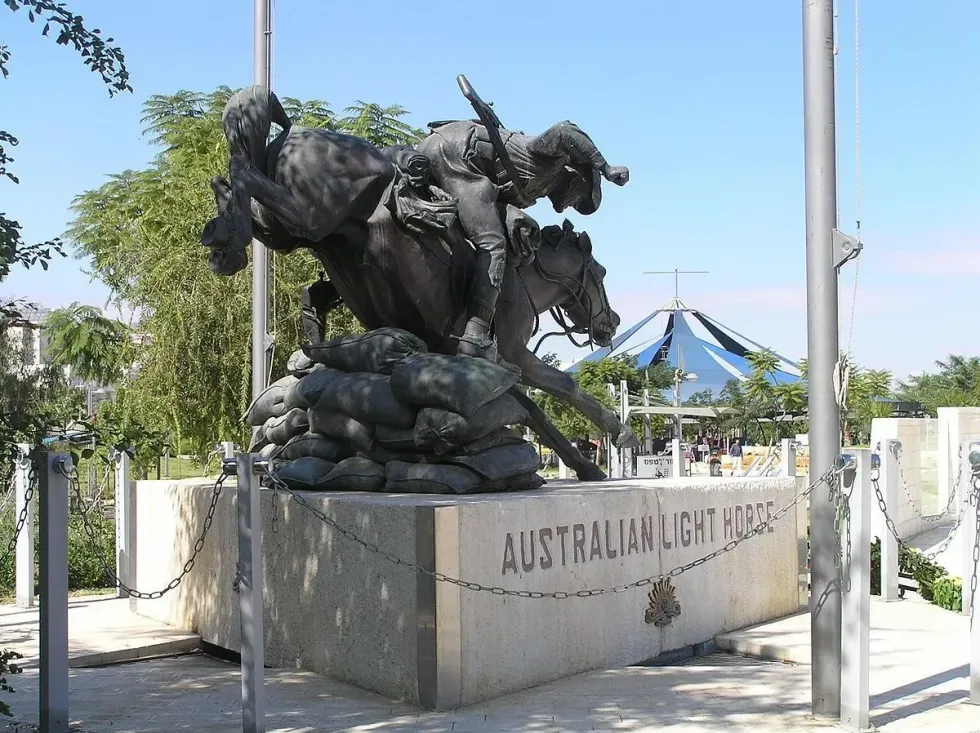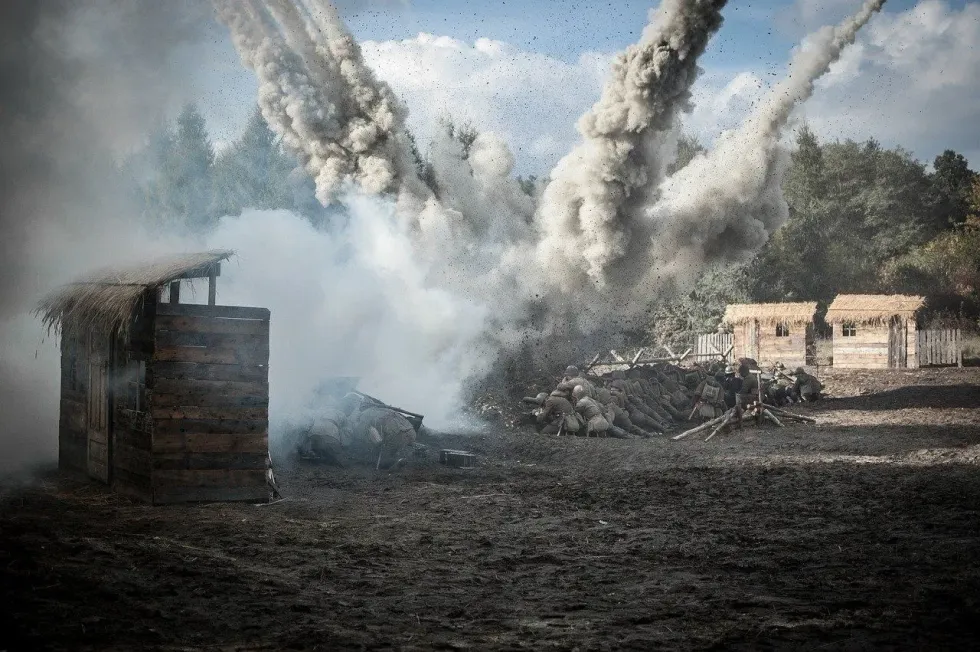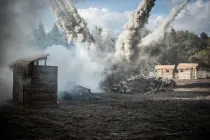Historical Battle Of Beersheba Facts You Probably Didn't Know
At the time of the Battle of Beersheba, machine guns were quite new and highly dangerous weapons.
The light horse was not actually cavalry and could be called infantry on the back of a horse. They would carry bayonets and rifles instead of the typical British swords.
When the Egyptian Expeditionary Force (EEF) of the British Empire attacked the Yildirim army group garrison and captured them at Beersheba, starting the Sinai and Palestine campaign's Southern Palestine offensive of World War I, the Battle of Beersheba began.
This battle was fought on October 31, 1917.
XX Corps' 74th Yeomanry and 60th London divisions infantry from the south-west attacked in limitation in the morning.
Then the Desert Mounted Corps or Anzac Mounted Division launched several attacks on the strong defenses dominating Beersheba's eastern side, which resulted in their capture in the late afternoon.
Soon after this incident, the 12th and 4th Australian Light Horse Regiment of the Australian Mounted Division ordered a charge by mounted infantry, holding bayonets that were the only weapon they could use during a mounted attack because they sling their rifles on their backs.
A group from the two regiments dismounted to launch an attack on Tel es Saba that was defending Beersheba, whereas the remaining light horsemen continued to charge into the town and captured both parts of the garrison that was withdrawing and in the region.
Who fought in the Battle of Beersheba?
The Battle of Beersheba was fought between British Empire and the Ottoman Forces with its German allies.
One of the most popular mounted troops' charges is the battle of Beersheba by the 4th Australian Light Horse Regiments. It was also the first World War I victory in Australian history and the last cavalry charge in history.
The Ottoman trenches and EEF improved their communication line, laying more water and railway lines, and sent machine guns, ammunition, and allied forces for defending the front lines.
The Ottoman line of communication shortened by Sinai retreat and EEF that were advancing through the Sinai Peninsula to southern Palestine lengthened their communication line. During the first World War, French, British, and Russian (allied) forces were on one side and the Austro-Hungarian, German, and Turkish forces (central forces) on the other.
The British Empire extended around the world, to Israel, Egypt, and other Middle East regions. The Turkish also had their empire, called the Ottoman empire.
However, the Ottoman empire was not as big as the British forces, they had highly dedicated Ottoman soldiers.
The German-led Turkish forces tried to capture the Suez Canal controlled by the British on January 26, 1915. After the two Turkish attacks failed, the offensive favored the British forces sustaining around 30 fatalities, whereas the Turkish had around 1,500 casualties.
Armies from New Zealand, Britain, and north of Sinai Peninsula of the EEF fought for a day in the Negev desert. With the dying sun in the Negev Desert on October 31, 1917, the Australian light horse divisions captured the Beersheba town causing the important battle of the First World war in the Sinai Palestine campaign.
The Beersheba battle was a turning point that changed Allied fortunes against the German and Ottoman Empire across the Middle East war zone.
This showed the Maneuver Warfare success in the area and the outcome of the war was impacted by the power of mounted troops.
When the Australian light horse group captured Beersheba and captured all the main wells, this marked the start of the victory of the British in the Middle East. The capture of Beersheba was an important event for the Sinai-Palestine campaign, for the entire duration of the war.
The army involved in the Battle of Beersheba was from India, Australia, Rhodesia, and New Zealand. On the other hand, the German Empire and the Ottoman Empire fought together.
Some leaders and commanders who were part of the British Empire during the period of World War I were Harry Chauvel and Philip Chetwode. Leaders and commanders involved with the Ottoman garrison were Ismet Bey, Fevzi Pasha, and Friedrich Freiherr Kress von Kressenstein.
Several units were involved in the war. The III Corps of the Seventh Army of the Yildirim army group had 67th Infantry Regiment and 81st Infantry Regiment, 2nd Regiment, and 48th Infantry Regiment.
The XX Corps of the EEF had the 74th Yeomanry, 60th London, and 10th Irish Divisions and Imperial Camel Brigade. There were also the 7th Mounted Brigade and Australian and Anzac Mounted Divisions of the Desert Mounted Corps.
Battle Of Beersheba Summary
This battle involved the great mounted charge by the 4th Light Horsemen in 1917, October. Those 800 young men of the ANZAC or the army corps of New Zealand and Australia are still remembered for their contribution, which changed the path of World war I.
Several Light Horsemen, who were involved in this Battle of Beersheba were already a part of the Gallipoli battle and had proven themselves, but with no horses. A total of 31 from the Light Horse regiment were killed, and 36 were wounded with more than 60 horses wounded and 70 died.
Around 60,000 Allied troops got access to water due to the victory in Beersheba.
The horses for this battle were bred for tough rural conditions. These horses carried heavy supply packs during the Palestine campaign along with their rider, in high temperatures.
In spite of the heroism of horses, the government of Australia wanted to quarantine these animals and did not want to bear the cost of care for the horses that survived. Good and healthy horses were sent to Britain for breeding and some were sold off as horse meat.
The 100 men that were a part of an indigenous tribe and other troopers were of Singapore, Hong Kong, Chinese and Malaysian descent, as per the research project called Beersheba 100 years.
The Lancer Regiment of New South Wales was formed in 1885, each group was given its territorial name. This was renamed as 1st Australian Light Horse Brigade in 1908.
The Australian Light Horse led to a victory in Beersheba and even engaged in hand-to-hand combat with Turkish defenses.
Although Australian troops outnumbered the Ottoman garrison, without the Australian Light Horsemen present in the mid-afternoon, they would not have captured Beersheba by night. Also, if the fight drew out for long, then all vital wells would have been destroyed.
The commander of EEF of the South Palestine Offensive stated that this was a surprise attack from the Yeomanry and London troops with the support of the British artillery and Light horsemen.

Battle Of Beersheba Timeline
The timeline of the Battle of Beersheba starts with preliminary moves on October 24 until October 31, 1917.
By mid-1917, when the third Ypres Offensive started on the Western Front, the defensive Ottoman position in south Palestine was in Gaza's coastal city. The Ottoman defensive line stretched across the city's southeast region opposite to the advancing British on the north side towards Palestine.
The British previously could not secure Ghaza even with two battles and it became more restricted after the two battles. General Edmund Allenby reached Egypt in late June.
He adopted the advice of General Chetwode, who suggested that they must instead focus on the extreme eastern region of the Ottoman defensive line to capture Beersheba. This also included the surprise attack.
Beersheba was defended by a small garrison with about 4,000 men under Colonel Ismat Bey's command with more than 24 field guns and 60 machine guns.
The Turkish trenches defended the town on the southern, western, and to some extent on the eastern outskirts of the town. There was no barbed wire of any kind for attacking force to deal with.
The Ottoman forces at Beersheba were under strength. This town had a major railway junction and 17 water wells.
As per the plan and under the command of Allenby, they moved forward to capture Beersheba before launching the third battle on Gaza.
They planned to attack Beersheba in a day without destructing any of its wells. So, infantry attack and concerted artillery moved on to the western side of the town with two British divisions advancing towards the main Ottoman defenses.
Simultaneously, the Anzac division was mainly made of cavalry bridges, positioned themselves in the east so as to swoop in the center of the town.
The Ottoman forces would retreat north in case of defeat, destructing major wells in the city as they left. Around the second half of October, maneuver warfare strategy began with six days of bombardment of Allied artillery at Gaza as a diversion to keep Ottoman forces away from Beersheba.
Planned misinformation was also spread to convince Ottoman and German commanders about a British attack about to take place on the coastal city, while the Anzac and British were set in the east to start the third Gaza attack.
Who won the Battle of Beersheba?
The Battle of Beersheba was won by the British.
Sir Philip Chetwode, the lieutenant-general ordered a bombardment at 6 am, on October 31, 1917, by British artillery on the Ottoman line located on the southwest and west of Beersheba outskirts. Along with 100 field guns, cannons were also fired in the complete Turkish positions, and 20 specifically targeted the Ottoman artillery batteries.
Ion Idriess, the 45th Australian Light Horse observed that shrapnel puffs were floating over the redoubts, while the smoke cloud covered the trenches.
The explosion of shells was clear and sharp.
The 60th London Division units attacked the 1070 Hill as smoke masked the targets, directly in front of the main line of Ottoman forces. By noon, the 74th Yeomanry Division moved forward capturing the objective with 1100 casualties.
In northeast Beersheba, Anzac Mounted Division units moved forward at 9 am, toward Tel el Sakati to block Beersheba Hebron road. They then advanced towards the Tel El Saba, where there was a large number of Ottoman men.
This move was made to block the enemy from retreating and advancing from Hebron, removing the Ottoman position from Beersheba's eastern side.
The 2nd Light Horse Brigade captured the Tel El Saba. After this, Major General moved the field headquarters of the Anzac Munter Division.
At the same time, the Ottoman artillery started to target the new position with bombs being dropped by the German aircraft. The aerial attacks continued all afternoon.
Chaytor then ordered both the 2nd and 1st Light Horse brigade to advance on foot from Tel El Saba, toward the mosque and to join the brigades on move. It took them little more than two hours to reach the designated region.
The final phase of this battle started in the evening around 4 pm, when William Grant, the Brigadier General ordered the 4th Light Horsemen to get into attack formation. Ismet Bey, the Ottoman garrison commander recognized the imminent defeat, so, ordered the destruction of water wells in Beersheba and the retirement of the garrison towards the north.
Why was the Battle of Beersheba important?
The Battle of Beersheba was important because the state balanced the right side of the defensive barricading of Gaza.
Just after 10 minutes past 4 pm, the 4th and the 12th Light Horse Regiments of the Victorian men and New South Wales men, respectively, moved across the Wadi Abu Sha'ai, then formed behind a 'W' road.
The 11th was ordered to follow the 4th and 12th Light Horse groups in reverse, 1.8 mi (or 3 km) southwest from their position.
Each of these regiments had 400 troopers. When all the Light Horse troopers charged at Ottoman forces towards town, the Turkish soldiers stood at their positions awaiting orders.
As the Australian Light Horse regiments got closer, Turkish gunners aimed and got ready to fire. At the sight of the British cavalry, the Turkish men received the order to 'fire at will'.
These gunmen open fired on the charging horsemen. Many Australian horsemen lost their lives, falling off the saddle, however, the comrades did not stop charging.
Now, Turkish gunmen realized their mistakes. Each gunman should have adjusted their sight range.
The Anzac troops were coming in so fast that most of the gunmens' shots went right over the heads of the troopers. So, the gunmen could not kill more men that were approaching.
Just within a few seconds, both Anzac Light Horse regiments reached the trenches of the Ottoman forces. The 12 Light Horse regiment men jumped over the enemy trenches, continuing towards Beersheba to capture its major wells.
The 12th Light Horse regiment men were able to get control over the wells. More British army regiments were called in for guarding the surrendered 1,000 Turkish soldiers and also to secure the region.
Only two Australian light horse regiments of 800 men successfully captured the important town of Palestine, Beersheba, and they got the most valuable wells, which the army needed for drinking water.
These Light Horsemen differentiated themselves in Jerusalem and Shemakh victories.
The victory at the Battle of Beersheba was an indirect result of the Allies taking gradual control over the remaining parts of Israel, which was followed by a conquest of the complete Middle East of the Turkish Empire.
After this battle, some of these men were involved in many war zones across Europe helping the Allies win World War I.
We Want Your Photos!
More for You
Bachelor of Engineering specializing in Aeronautical/Aerospace Technology, Master of Business Administration specializing in Management

Arpitha RajendraBachelor of Engineering specializing in Aeronautical/Aerospace Technology, Master of Business Administration specializing in Management
With a background in Aeronautical Engineering and practical experience in various technical areas, Arpitha is a valuable member of the Kidadl content writing team. She did her Bachelor's degree in Engineering, specializing in Aeronautical Engineering, at Nitte Meenakshi Institute of Technology in 2020. Arpitha has honed her skills through her work with leading companies in Bangalore, where she contributed to several noteworthy projects, including the development of high-performance aircraft using morphing technology and the analysis of crack propagation using Abaqus XFEM.
Disclaimer
1) Kidadl is independent and to make our service free to you the reader we are supported by advertising. We hope you love our recommendations for products and services! What we suggest is selected independently by the Kidadl team. If you purchase using the Buy Now button we may earn a small commission. This does not influence our choices. Prices are correct and items are available at the time the article was published but we cannot guarantee that on the time of reading. Please note that Kidadl is a participant in the Amazon Services LLC Associates Program, an affiliate advertising program designed to provide a means for sites to earn advertising fees by advertising and linking to Amazon. We also link to other websites, but are not responsible for their content.
2) At Kidadl, we strive to recommend the very best activities and events. We will always aim to give you accurate information at the date of publication - however, information does change, so it’s important you do your own research, double-check and make the decision that is right for your family. We recognise that not all activities and ideas are appropriate for all children and families or in all circumstances. Our recommended activities are based on age but these are a guide. We recommend that these ideas are used as inspiration, that ideas are undertaken with appropriate adult supervision, and that each adult uses their own discretion and knowledge of their children to consider the safety and suitability. Kidadl cannot accept liability for the execution of these ideas, and parental supervision is advised at all times, as safety is paramount. Anyone using the information provided by Kidadl does so at their own risk and we can not accept liability if things go wrong.
3) Because we are an educational resource, we have quotes and facts about a range of historical and modern figures. We do not endorse the actions of or rhetoric of all the people included in these collections, but we think they are important for growing minds to learn about under the guidance of parents or guardians.







